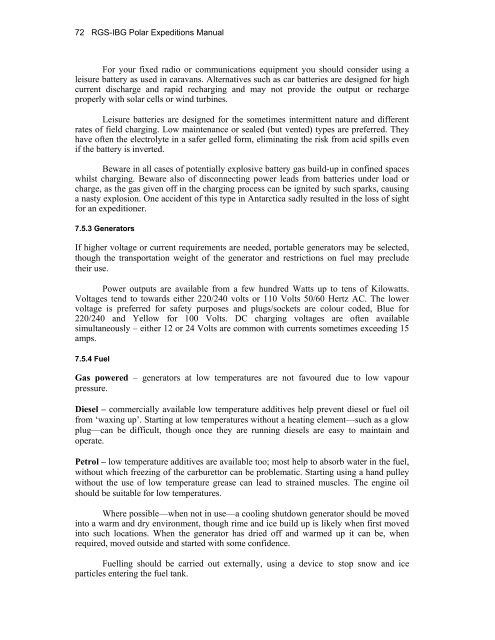Edited by Rachel Duncan 4th Edition ISBN 0-907649-91-2 London ...
Edited by Rachel Duncan 4th Edition ISBN 0-907649-91-2 London ...
Edited by Rachel Duncan 4th Edition ISBN 0-907649-91-2 London ...
You also want an ePaper? Increase the reach of your titles
YUMPU automatically turns print PDFs into web optimized ePapers that Google loves.
72 RGS-IBG Polar Expeditions Manual<br />
For your fixed radio or communications equipment you should consider using a<br />
leisure battery as used in caravans. Alternatives such as car batteries are designed for high<br />
current discharge and rapid recharging and may not provide the output or recharge<br />
properly with solar cells or wind turbines.<br />
Leisure batteries are designed for the sometimes intermittent nature and different<br />
rates of field charging. Low maintenance or sealed (but vented) types are preferred. They<br />
have often the electrolyte in a safer gelled form, eliminating the risk from acid spills even<br />
if the battery is inverted.<br />
Beware in all cases of potentially explosive battery gas build-up in confined spaces<br />
whilst charging. Beware also of disconnecting power leads from batteries under load or<br />
charge, as the gas given off in the charging process can be ignited <strong>by</strong> such sparks, causing<br />
a nasty explosion. One accident of this type in Antarctica sadly resulted in the loss of sight<br />
for an expeditioner.<br />
7.5.3 Generators<br />
If higher voltage or current requirements are needed, portable generators may be selected,<br />
though the transportation weight of the generator and restrictions on fuel may preclude<br />
their use.<br />
Power outputs are available from a few hundred Watts up to tens of Kilowatts.<br />
Voltages tend to towards either 220/240 volts or 110 Volts 50/60 Hertz AC. The lower<br />
voltage is preferred for safety purposes and plugs/sockets are colour coded, Blue for<br />
220/240 and Yellow for 100 Volts. DC charging voltages are often available<br />
simultaneously – either 12 or 24 Volts are common with currents sometimes exceeding 15<br />
amps.<br />
7.5.4 Fuel<br />
Gas powered – generators at low temperatures are not favoured due to low vapour<br />
pressure.<br />
Diesel – commercially available low temperature additives help prevent diesel or fuel oil<br />
from ‘waxing up’. Starting at low temperatures without a heating element—such as a glow<br />
plug—can be difficult, though once they are running diesels are easy to maintain and<br />
operate.<br />
Petrol – low temperature additives are available too; most help to absorb water in the fuel,<br />
without which freezing of the carburettor can be problematic. Starting using a hand pulley<br />
without the use of low temperature grease can lead to strained muscles. The engine oil<br />
should be suitable for low temperatures.<br />
Where possible—when not in use—a cooling shutdown generator should be moved<br />
into a warm and dry environment, though rime and ice build up is likely when first moved<br />
into such locations. When the generator has dried off and warmed up it can be, when<br />
required, moved outside and started with some confidence.<br />
Fuelling should be carried out externally, using a device to stop snow and ice<br />
particles entering the fuel tank.

















